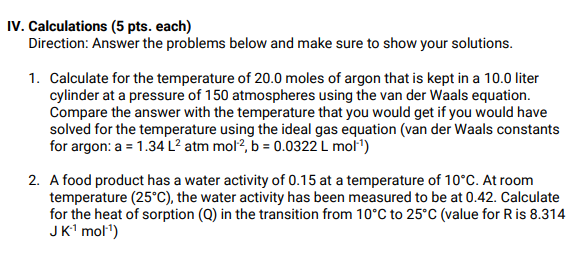Calculate for the temperature of 20.0 moles of argon that is kept in a 10.0 liter cylinder at a pressure of 150 atmospheres using the van der Waals equation. Compare the answer with the temperature that you would get if you would have solved for the temperature using the ideal gas equation (van der Waals constants for argon: a = 1.34 L² atm mol?, b = 0.0322 L mol")
Calculate for the temperature of 20.0 moles of argon that is kept in a 10.0 liter cylinder at a pressure of 150 atmospheres using the van der Waals equation. Compare the answer with the temperature that you would get if you would have solved for the temperature using the ideal gas equation (van der Waals constants for argon: a = 1.34 L² atm mol?, b = 0.0322 L mol")
Introductory Chemistry: A Foundation
9th Edition
ISBN:9781337399425
Author:Steven S. Zumdahl, Donald J. DeCoste
Publisher:Steven S. Zumdahl, Donald J. DeCoste
Chapter13: Gases
Section: Chapter Questions
Problem 118AP: 2.50Lcontainer at 1.00atm and 48Cis filled with 5.41gof a monatomic gas. Determine the identity of...
Related questions
Question
Please answer only number 2
Handwritten or computerized solution is accepted as long it is readable and detailed.

Transcribed Image Text:IV. Calculations (5 pts. each)
Direction: Answer the problems below and make sure to show your solutions.
1. Calculate for the temperature of 20.0 moles of argon that is kept in a 10.0 liter
cylinder at a pressure of 150 atmospheres using the van der Waals equation.
Compare the answer with the temperature that you would get if you would have
solved for the temperature using the ideal gas equation (van der Waals constants
for argon: a = 1.34 L² atm mol?, b = 0.0322 L mol")
2. A food product has a water activity of 0.15 at a temperature of 10°C. At room
temperature (25°C), the water activity has been measured to be at 0.42. Calculate
for the heat of sorption (Q) in the transition from 10°C to 25°C (value for R is 8.314
JK' mol")
Expert Solution
This question has been solved!
Explore an expertly crafted, step-by-step solution for a thorough understanding of key concepts.
Step by step
Solved in 2 steps with 2 images

Knowledge Booster
Learn more about
Need a deep-dive on the concept behind this application? Look no further. Learn more about this topic, chemistry and related others by exploring similar questions and additional content below.Recommended textbooks for you

Introductory Chemistry: A Foundation
Chemistry
ISBN:
9781337399425
Author:
Steven S. Zumdahl, Donald J. DeCoste
Publisher:
Cengage Learning

Chemistry for Engineering Students
Chemistry
ISBN:
9781337398909
Author:
Lawrence S. Brown, Tom Holme
Publisher:
Cengage Learning

Chemistry by OpenStax (2015-05-04)
Chemistry
ISBN:
9781938168390
Author:
Klaus Theopold, Richard H Langley, Paul Flowers, William R. Robinson, Mark Blaser
Publisher:
OpenStax

Introductory Chemistry: A Foundation
Chemistry
ISBN:
9781337399425
Author:
Steven S. Zumdahl, Donald J. DeCoste
Publisher:
Cengage Learning

Chemistry for Engineering Students
Chemistry
ISBN:
9781337398909
Author:
Lawrence S. Brown, Tom Holme
Publisher:
Cengage Learning

Chemistry by OpenStax (2015-05-04)
Chemistry
ISBN:
9781938168390
Author:
Klaus Theopold, Richard H Langley, Paul Flowers, William R. Robinson, Mark Blaser
Publisher:
OpenStax

Introductory Chemistry: An Active Learning Approa…
Chemistry
ISBN:
9781305079250
Author:
Mark S. Cracolice, Ed Peters
Publisher:
Cengage Learning

Chemistry: The Molecular Science
Chemistry
ISBN:
9781285199047
Author:
John W. Moore, Conrad L. Stanitski
Publisher:
Cengage Learning

Principles of Modern Chemistry
Chemistry
ISBN:
9781305079113
Author:
David W. Oxtoby, H. Pat Gillis, Laurie J. Butler
Publisher:
Cengage Learning